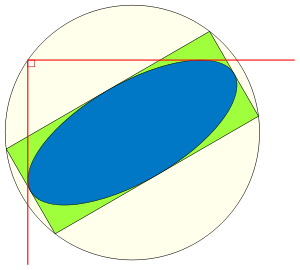Director circle

In geometry, the director circle of an ellipse or hyperbola (also called the orthoptic circle or Fermat–Apollonius circle) is a circle consisting of all points where two perpendicular tangent lines to the ellipse cross each other.
Properties
The director circle of an ellipse circumscribes the minimum bounding box of the ellipse. It has the same center as the ellipse, with radius , where and are the semi-major axis and semi-minor axis of the ellipse. Additionally, it has the property that, when viewed from any point on the circle, the ellipse spans a right angle.[1]
The director circle of a hyperbola has radius √a2 - b2, and so, may not exist in the Euclidean plane, but could be a circle with imaginary radius in the complex plane.
Generalization
More generally, for any collection of points Pi, weights wi, and constant C, one can define a circle as the locus of points X such that
The director circle of an ellipse is a special case of this more general construction with two points P1 and P2 at the foci of the ellipse, weights w1 = w2 = 1, and C equal to the square of the major axis of the ellipse. The Apollonius circle, the locus of points X such that the ratio of distances of X to two foci P1 and P1 is a fixed constant r, is another special case, with w1 = 1, w2 = −r2, and C = 0.
Related constructions
In the case of a parabola the director circle degenerates to a straight line, the directrix of the parabola.[2]
Notes
- ↑ Akopyan & Zaslavsky 2007, pp. 12–13
- ↑ Faulkner 1952, p. 83
References
- Akopyan, A. V.; Zaslavsky, A. A. (2007), Geometry of Conics, Mathematical World, 26, American Mathematical Society, ISBN 978-0-8218-4323-9.
- Cremona, Luigi (1885), Elements of Projective Geometry, Oxford: Clarendon Press, p. 369.
- Faulkner, T. Ewan (1952), Projective Geometry, Edinburgh and London: Oliver and Boyd
- Hawkesworth, Alan S. (1905), "Some new ratios of conic curves", The American Mathematical Monthly, 12 (1): 1–8, doi:10.2307/2968867, MR 1516260.
- Loney, Sidney Luxton (1897), The Elements of Coordinate Geometry, London: Macmillan and Company, Limited, p. 365.
- Wentworth, George Albert (1886), Elements of Analytic Geometry, Ginn & Company, p. 150.